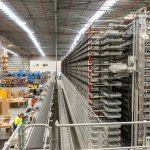Facilities management software is proving its worth as inflation bites

Managing buildings as efficiently as possible has always been a priority to keep running costs low. Centralizing the administration of equipment and its maintenance, as well as accurately capturing incident reports, gives facilities teams a valuable heads-up on what needs to be done and when. Making this information readily available, together with building plans and asset identifiers, helps crews to organize their schedules and keep on top of the demands of facilities management in 2022.
It’s for exactly these reasons that facilities management software has become a ‘must have’ item. Management tasks can be classified into four major groups – equipment, maintenance, assets, and work orders. The latter is the ‘glue’ that holds operations together and begins with identifying the task, rotating through creation, approval, assignment, closure, and (periodic) review. With facilities home to hundreds of assets, a digital system that provides users with a clear, up-to-date status report on where each order is in the cycle becomes invaluable. Team leaders can query such software to help prioritize tasks and divide them efficiently among their technicians.
Helping with inventory
Computerized maintenance management systems can help with inventory by sending alerts when parts or other consumables are running low. And, unlike paper-based or erasable whiteboard workflows, tickets don’t get lost or forgotten about. Also, by capturing data over time, systems can provide input for predictive maintenance – the holy grail of keeping upkeep costs to the absolute minimum ( to read about how aviation does this, click here).
As new assets are purchased, their likely maintenance intervals can be estimated based on the performance of existing infrastructure and any changes in duty cycles factored into the equation. But modern facilities management tools are more than just about keeping equipment in tip-top condition. They help with the day-to-day running of a building in other ways as well by managing room bookings and capturing visitor details. The goal is for all of the building’s operations to run as one, in concert, thanks to the unified systems.
When it comes to compliance, certificates can be uploaded and integrated into reporting tasks. If set up correctly, the days of searching for misplaced paperwork should be long gone. In fact, thanks to digital signing, in combination with the use of portable devices such as smartphones and tablets, the need for printouts can be done away with in many cases.
Purchasing pointers
Mobile devices are a factor when thinking about what facilities management software is the right match for an organization. Do staff want to access work orders and other information through an app or is a web interface sufficient? Also, what other systems need to be integrated? Before hitting the ‘buy now’ button, it’s worth double-checking the product specs to confirm compatibility with in-house or other third-party solutions. And, of course, discussing your requirements with providers.
It’s good to keep an open mind when running through the feature list. Services such as speech recognition might not feel like a priority at the time, but having the ability to call up information hands-free could turn out to be a time-saver for engineers when they have their hands full. Other aspects worth thinking about are cloud options, which make backups a breeze, and – as hinted earlier – the ability to run data through some kind of artificial intelligence engine to spot operating trends.
Pattern matching
Having a helping hand, albeit a digital one, is always valuable as facilities management is rarely straightforward. This applies now more than ever with next-generation flexible workspaces that have to juggle capacity considerations as well as meeting room provisions to manage the demands of in-person and remote interactions. The headline view is that many employees will want to continue working from home and being ‘hybrid-ready’ is gold for business continuity planners. But unknowns remain and landlords and tenants are still waiting to see what the optimum combination looks like.
The answer will lie in the data and having it at your fingertips thanks to facilities management software will put those users ahead of the rest in being able to plan for the future. And this includes finding the right suppliers. Diversification is proving to be a prime strategy for heading off shortages arising from supply chain hiccups and again buildings management systems can hold a list of trusted suppliers, with notes on who to contact first and which ones to try next.
Feelgood factor
Summing up, finding the right facilities management software can transform an unhappy workplace into a slick operation. Staff no longer feel overwhelmed as the system can take the strain, allowing team members to be strategic rather than always being caught in a firefight. Progress can be tracked and charted and the knowledge made accessible to all – for example, to help new starters and contractors to get up to speed.
Facilities management has changed for good, with decision-makers no longer quibbling over whether to invest in software or not. Instead, the question they now need to answer is which package is going to deliver the most savings to help them navigate the latest bumps in the road – high energy costs, and rising inflation.









